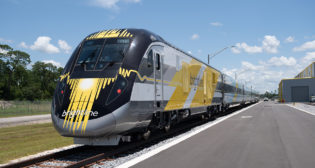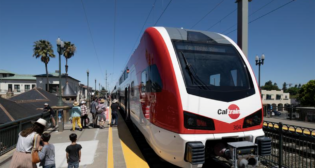Commentary
SP 4449 readied for another 15 years of service
Written by
David Thomas, Canadian Contributing Editor
For the past four decades, former Norfolk & Western and Southern Pacific locomotive engineer Doyle McCormack has coddled the most familiar steam locomotive operating in North America.

Now, Chief Mechanical Officer McCormack and his team of volunteers are re-assembling the 433-ton semi-streamliner after a major boiler tear-down in the spacious new enginehouse it shares with two other steam locomotives, rescued from vandalism and decay in Oaks Park (Spokane, Portland & Seattle 4-8-4 700 in 1986 and Oregon Railroad and Navigation 4-6-2 197 in 1996).
Erected by Lima Locomotive Works in 1941, the big 4-8-4 represents the peak of “super power” locomotive technology. “Steam didn’t develop much after that,” says McCormack, still 4449’s regular driver. The locomotive was balanced for a top speed of 106 mph and, says its engineer, strides most smoothly between 60 and 70 mph.
Mandatory boiler inspections have been rescheduled from every four years at the apex of steam power, to 15 years in the era of light-duty excursion service. The 4449’s last 15-year certificate expired in 2012, just as it and its stable mates were removed from Union Pacific’s Brooklyn Roundhouse, to make way for expansion of UP’s Portland container terminal.
Just in time for 4449’s boiler work, Oregon’s Rail Heritage Center opened its new roundhouse-style doors to shelter all three steamers—each still owned by the City of Portland, but maintained entirely by donated time and money. The complex is nicely situated between the Oregon Museum of Science and Industry and steam-friendly Union Pacific’s main line. Oregon Pacific short line provides diesel-hauled passenger rides from the center, which is also served by both the Eastside Streetcar line, and the new Portland-Milwaukie Light Rail system.
One of the $6 million facility’s rare luxuries for modern steam mechanics is an indoor drop table that permits the removal of wheelsets without lifting the locomotive. When funds permit, the turntable salvaged from the demolished Brooklyn Roundhouse will be installed outside with five radial display tracks.
Bright with natural light, and spacious with an open-plan machine shop running the 240-foot length of the double-track engine house, the Oregon Rail Heritage Center was built to allow visitors up-close access to the machines and their maintainers. This spring, visitors were even invited to poke their heads through a man-size opening, cut through the firebox, and view the exposed crown, side, and rear flue sheets. The firebox interior was chalked with a grid of foot-square sections, whose intersections served as targets for ultrasonic testing of the steel’s thickness and integrity.
The only part of the boiler to show suspect thinning was the rounded, step-like lip, connecting the fire grate from the flue sheet. The section was cut out and a replaced with a patch crafted in Utah.
From inside the firebox, the flue sheet with its array of large and small holes recalls a slice of densely pocketed Swiss cheese. Of the boiler’s 198 3.5-inch superheater flues, 90 were removed, along with many of the smaller, two-inch fire tubes. The flues contain boiler-length, U-shaped steam tubes that start and end at the superheater manifold, tucked into the top and rear of the front-end smokebox.
The saturated steam produced at 417 degrees F by the boiling water (at a pressure of 300 pounds per square inch) is passed back through the steam tubes, and superheated to 750 degrees F. The superheated steam expands an amazing 1,700 times in volume when it is released into the engine’s 50,000-cubic-inch cylinders.
The two 25.5-inch diameter, double-faced pistons travel 32 inches on each stroke, powered in each direction. Valve ports at each end of the cylinder bore alternately allow steam to push against a piston face and, at the end of the stroke, release the expanded steam through a nozzle under the smokestack, thus creating a venturi-effect vacuum draw in the smokebox, superheater flues, firetubes, and firebox.
The locomotive’s mechanicals are in excellent condition, including the original, hand-polished main and side rods. Notably, for the evolutionary end of steam power, the driving wheel bearings are plain, not roller; and the 13-inch axles are hollow tubes. You can in fact look right through the length of the axle to the other side of the locomotive. The white stars painted around each axle opening are Southern Pacific code to advise lubricators of the bearing type.
McCormack enjoyed his first cab ride in 1953 aboard Nickel Plate Road Berkshire 743, a privilege arranged by his NKP dispatcher dad. He decided then and there to be a locomotive engineer, though “much to my despair,” steam was gone by the time he had begun his career. Driving main line diesels did, however, enable his eventual Freedom Train assignment, running 4449 over main line trackage in every state west of the Mississipi: “Ninety percent of the work is handling the train, not running the engine.”
McCormack expects 4449 to be back in steam by the end of 2014, and to be good for another 15 years of main line excursions. With his and all other labor contributed by Portland’s steam enthusiasts, the cost of the boiler inspection will be a mere $10,000 per year of anticipated service. “It will cost $150,000, because that’s all the money we have for it,” McCormack says.





